This is a Welta Weltini II, a 35mm folding rangefinder camera made by Welta Kamerawerke in Freital, Germany between the years 1938 and 1941. The Weltini II is similar to the Weltini I with a different top plate and cosmetics but is otherwise the same. Both cameras were rangefinder equipped versions of the scale focus only Welta Welti. All of the cameras in the Welti and Weltini family borrow heavily from the features and design of the German built Kodak Retina but were sold at a discount price. Weltini cameras are well built examples of pre-war German 35mm cameras, and came with quality lenses and shutters.
Film Type: 135 (35mm)
Lens: 5cm f/2 Schneider-Kreuznach Xenon uncoated 6-elements in 5-groups
Focus: 0.7 meters to Infinity
Viewfinder: Coincident Image Coupled Rangefinder
Shutter: Compur Rapid Leaf
Speeds: B, 1 – 1/500 seconds
Exposure Meter: None
Battery: None
Flash Mount: None
Weight: 641 grams
Manual: https://www.cameramanuals.org/pdf_files/welta_weltini_ii.pdf
How these ratings work |
The Welta Weltini was a more affordable competitor to the Kodak Retina II and shares all of the same features, including the same Compur shutter and Schneider lenses. Where the two cameras differ though is in the ergonomics. Some of the controls on the Weltini are a bit haphazardly implemented, and a few other controls tend to slow you down while shooting. Once you can get past the ergonomics, the Weltini is a well built camera with excellent optics that makes images as good as anything out there. | ||||||
| Images | Handling | Features | Viewfinder | Feel & Beauty | History | Age | |
| 2 | 1 | 2 | 1 | 2 | 1 | 40% | |
| Bonus | none | ||||||
| Final Score | 12.6 | ||||||
History

Welta is yet another camera company from the Dresden area of Germany where a huge number of camera makers were based in the early to mid 20th century. Founded in 1914 by German businessmen, Theodor Weber and Walter Waurich in Freital, a nearby suburb of Dresden. Originally named Weeka-Kamera-Werk, the company changed it’s name to Welta-Kamera-Werk in 1919 to include the name Welta which was taken from their early plate cameras.
As was the case of many Dresden area camera makers, Welta had to complete with a large number of companies making similar products. Welta would attempt to carve out a market for themselves by selling a lot of “white label” products to dealers, and by exporting their cameras to other markets including the United States.
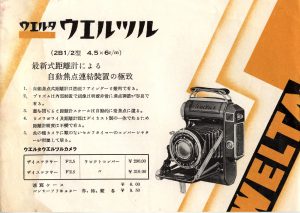
Welta was one of the first German makers to actively market their cameras in Japan, selling models like the roll film Weltur. The page to the right shows the camera in a Japanese language catalog dated April 1936 along with several other of the company’s models. The Japanese camera market was still in it’s infancy in those days, so being able to get German made products would have likely made them very appealing to photographers at the time.
Whether in Germany, Japan, or elsewhere, Welta was most well known for their medium format sheet and roll film cameras, but in 1935 would jump on the 35mm bandwagon started with the Kodak Retina and produce their own compact folding model, called the Welti.
As was the case of the Certo Dollina which was a competing 35mm folding camera released in 1935, the Welti shared many design similarities to the Retina, but was not an outright copy. The Welti was it’s own model, and competed with August Nagel’s model by undercutting it in price. Selling for about one-third less than a similar Retina, the Welti was an economical entry point to Kodak’s new 35mm film.
As both Kodak and Certo did with the Retina II and Dollina II, in 1936, Welta would release a rangefinder version of the Welti, which they called the Weltini. Featuring a coupled coincident image rangefinder, an upgraded Compur shutter, and a selection of lenses from an f/3.5 Leitz Elmar lens to an f/2 Schneider Xenon lens, the Weltini was a well equipped model, featuring all of the same features of their more expensive competition.
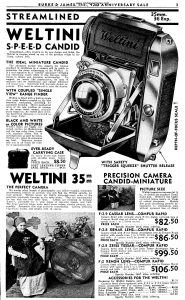
In a 1939 catalog for Burke & James of Chicago, the Weltini ranged in price from $82.50 to $106.50 with the top of the line Xenon lens. For comparison, Central Camera’s 1938 catalog lists the Kodak Retina II with the same f/2 Schneider Xenon at $140. These prices when adjusted for inflation compare to $1550, $2010, and $2585 respectively, today.
Two versions of the Weltini exist, with the only difference being in the design of the rangefinder housing. Neither version was marketed by Welta differently from the other, but today are differentiated as the Weltini I and Weltini II. The Weltini II reviewed here has narrower film advance and rewind knobs and a sleek metal top plate with curved edges that extends the entire length of the camera, compared to the earlier version that had squared off edges that only covered the rangefinder housing, and also came with taller advance and rewind knobs.
The Weltini would be produced until 1941, at which time all Welta camera production stopped as the factory transitioned to supporting the German war effort. Dresden is in what would become East Germany after World War II, and like other companies in the area, they would all fall under the control of Soviet leadership after the war.
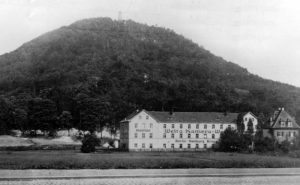
From 1948 and on, Welta would be a state-owned company known as VEB Welta-Kamera-Werk. Some models like the Welti would continue to be produced, but the rangefinder equipped Weltini was not one of them. The Welti would stay in production with some cosmetic changes and different lenses for quite some time. Instead of Schneider Xenons and the rare Leitz Elmar, the most common lenses were Zeiss Tessar and Meyer Trioplan lenses in Vebur and Cludor shutters.
Welta would continue to manufacture cameras using their own designs from before the war. In 1950, Welta would merge with Kamera-Werk Tharandt who themselves were once two separate companies known as Richter and Merkel. VEB Welta-Kamera-Werk would continue on, making lower cost East German versions of prewar Dresden area cameras until 1959 when the company merged to become VEB Kamera-and Kinowerk Dresden and later VEB Pentacon Dresden.
Today, nearly all prewar German cameras are collectible as they represent the German camera industry at the peak of their popularity and in an era of great innovation. Cameras like the Weltini are sought after, not because of who they were made by, but because they display well, and when maintained are still excellent shooters today. Many people like myself find it thrilling to have an early 20th century compact folding camera that uses 35mm film I can buy fresh today, to still make wonderful pictures with. Certainly, some models are worth more than others, but examples like this Welta Weltini are in high demand today and should be for years to come..
My Thoughts
Who doesn’t love pre-war German folding cameras?! With their all metal bodies, excellent lenses, and leather bellows and (usually) body coverings, early German folders represent some of the most collectable cameras ever made. Of course, brands like Zeiss-Ikon, Voigtländer, and Kodak make up some of the most collectable models, there are a huge number of folders from this era made by less common makers.
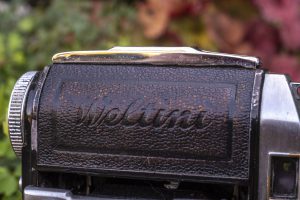
One of those less common makers is Welta, who was one of many Dresden area camera makers who made cameras that rivaled those of their competitors, but at a discount price. In July 2015, I reviewed the Welta Watson, a simple but still very good folder that would have favorably competed against the original Kodak Retina I.
This model was Welta’s top of the line 35mm camera. It improved upon lesser Weltixes and Watsons with a Schneider Xenon lens, Compur shutter, and a coupled rangefinder. When I first picked up this camera, I remarked at how solid it felt. At a weight of 641 grams, it exceeded that of a Retina II at 571 grams. Both cameras come from the same era, have a coupled rangefinder, Compur shutter, and Schneider Xenon 50/2 lens, but where is that additional weight?
When looked at side by side with a Retina, an immediate difference is evident, which is that when held to your eye in a landscape orientation, the door opens on the Retina to the right, and on the Weltini to the left. At first, I didn’t think much of this, thinking it was just an aesthetic choice, after all, Kodak’s own Bantam Special has the door on the left. But after taking a closer look at the camera, I noticed that the film advance and rewind knobs are on the bottom of the camera, not the top like you’d expect most cameras of this style. It was not until I compared the layout of the controls on this camera to that of the non-rangefinder Welta Welti, that I realized what had happened.
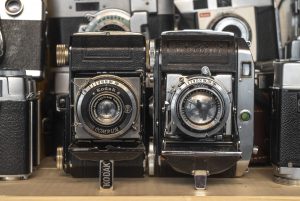
The Weltini is upside down! When the choice was made to add a rangefinder to the Welti body, rather than put it on the top of the camera, they put it on the bottom, giving the illusion that the knobs were on the bottom. When set on a table using the kickstand and the door facing down, it becomes clear that the Welti and Weltini are the same camera, just one has a rangefinder on the wrong side. Why did Welta do this? Was it a cost cutting measure so that they wouldn’t have to make changes to the film transport, or were they just trying to be different? The idea that the Weltini would have been a less expensive alternative to a Kodak Retina suggests that they did what they could to keep costs down, so this is most likely a result of keeping things cheap.

With the camera oriented with the viewfinder and rangefinder facing up and the door to the left, the top plate of the camera is dominated by a large depth of field table. The writing is in German, but the numbers are easy enough to figure out as it has measurements from f/2 to f/16, at distances from 1 meter to infinity. To the left of the scale is the exposure counter. The counter is additive, starting at zero and showing how many exposures have been made, and must be manually reset by a small slider on the back of the top plate. Above and to the left of the exposure counter is a smooth shutter release button. This button is not threaded for a shutter release, but there is a separate threaded hole on the Compur shutter for a release cable if you choose to use one. Finally, the only other thing visible on the top plate are two upward facing strap lugs near the edges.

Flipping the Weltini over, the bottom of the camera has the film rewind and advance knobs, a door release button, and 3/8″ tripod socket. If you wanted to mount the Weltini to a modern tripod, you would need to get a 3/8″ to 1/4″ adapter.
While looking at the bottom of the camera, you’ll notice a small chrome U-shaped button on the front face of the camera, above and to the right of the tripod socket on the bottom plate. This unlabeled button is a film transport lock release. This button must be pressed in between each exposure to unlock the film transport to be able to advance the film to the next exposure.
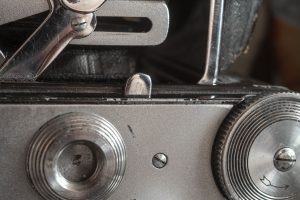
The Weltini also has a double exposure lock that prevents you from making double exposures. After pressing the shutter release, the double exposure lock is engaged, and the only way to disengage it is to advance the film to the next exposure, but you cannot advance the film until pressing this button first. The presence of both a film transport lock and double exposure lock confused the heck out of me when I first got this camera as I couldn’t figure out how to test it. Making matters worse, is you must have film in the camera to override the double exposure lock. Without film, the only other way to test the camera is to open the back and manually rotate the sprocket shaft with your finger, while simultaneously turning the film advance knob.
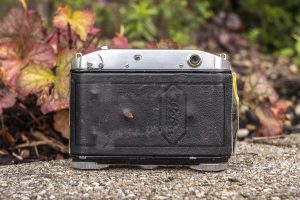
The camera’s back door is entirely covered in leather with a script Welta logo embossed into it. Unlike many post war cameras of the 20th century, the body covering is real leather, and despite being over 80 years old is still soft, with a nice amount of grip. Above the door, on the back of the top plate, from left to right is an unmarked swiveling lever that when pointing to the right is for normal film advance, but when pointing up, is for rewinding the camera. After loading in a new roll of film, you must remember to rotate this lever back to the film advance position, otherwise the shutter lock will not engage. In the center of the top plate is a small sliding switch which is the exposure counter reset. Slide it to the right and the counter goes back to zero. Finally, on the far right is the eyepiece for the viewfinder.
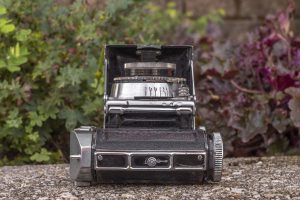
Opening the camera is done using a sliding release catch on the camera’s right side. From this angle, you also get a top down look at the shutter, and the focusing lever and focus scale.
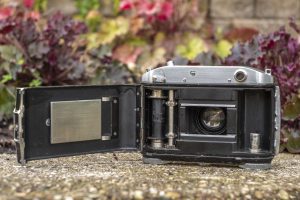
With the camera open, the film compartment looks surprisingly modern, just upside down. Where the rangefinder-less Welti has left to right film transport, the Weltini is right to left. The take up spool is single slotted and non removable. The film pressure plate is unpainted bare metal, and a small clip is on the door next to it to help maintain film flatness as it travels through the camera.
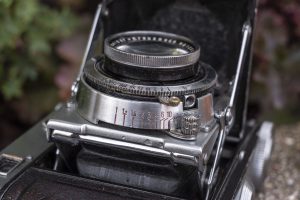
Up front, the Weltini looks like most folding 35mm cameras of the day. The Welta branded shutter is an unlabeled Compur-Rapid, with shutter speeds from 1 second to 1/500. The camera uses a focusing helix which is controlled by a lever on the side of the shutter below the viewfinder window. The shutter must be manually cocked before an exposure can be made via the arm near the 8 o’clock position around the lens (with the camera in a landscape orientation). Although the shutter release is coupled to the button on the top plate, you can still fire the shutter by manually pressing on the shutter release arm near the 5 o’clock position around the lens. Changing aperture is done by moving a small arm which is inconveniently located in between the door and the shutter. This location is pretty typical for most Compur shutters, but the Weltini’s right hinged door makes this difficult to get to.

The viewfinder is dark and very cramped, but is typical of the design found on 1930s rangefinder cameras. The rangefinder is a combined coincident image type with a yellow tinted circular rangefinder patch. Amazingly, the rangefinder was still accurate after all these years despite some desilvering that runs down the center of the beamsplitter.
Although small, the viewfinder works similarly to those found on pretty much every other rangefinder camera. I didn’t mind the small size of the rangefinder as much as I hated it’s location on the far right side of the camera. As a left eye shooter, I found this very uncomfortable to hold. In fact, I found that rotating the camera 90 degrees and holding it in a portrait orientation made it easier for me to use the viewfinder.
Welta marketed these cameras as economical alternatives to the Kodak Retina. Feature for feature, they compare favorably but in terms of ergonomics, the two cameras are very different. The upside down layout of the advance and rewind knobs, plus and overly complicated film transport slows you down while shooting, but is it enough to make for a miserable shooting experience, or is there enough good about the Weltini that these curious details can be easily overlooked? Keep reading…
My Results
In my initial assessment of the Weltini when I first got it, I had noticed that there was quite a bit of haze inside of the Xenon lens. I had removed the front and rear elements in order to flush the shutter, and was able to clean some of the haze, but there was more in between one of the cemented pairs which I could not get to. I certainly made it better than it was, but there was still enough that I was certain it would show up on film.
Whenever I shoot a camera with a hazy lens, I find that a black and white film with some grain helps balance out the haze a bit, so I chose a roll of heavily expired Kodak Plus-X that I had lying around. I had shot another roll like this some time ago and found the results to be very gritty, so I thought it would complement both the age of the Weltini and it’s lens.
As predicted, some haze showed up in the images, but not as much as I feared. There is a general softness to these images that aren’t unlike that of many prewar uncoated lenses. My choice of expired Kodak Plus-X was perfect as the small amount of grain and contrast of that film suited the softness, producing a whole roll of images with the type of character you can only get from an over 80 year old camera.

As is the case with every image I’ve ever shot through a Schneider-Kreuznach Xenon lens, the images are very sharp from corner to corner. There was no softness or vignetting in the corners suggesting that despite it’s age and condition, the Xenon lens still has a lot of life in it.
Although I didn’t stress the shutter, shooting Sunny 16 with a 125 speed film, exposures seemed pretty close to perfect, suggesting I could have been flexible with any number of slower or faster films.
Finally, despite the small and dark rangefinder, I did not struggle with focus as the entire roll was mostly in focus, with only a few missteps that were likely user error.
When it was first released, the Weltini was sold as an affordable alternative to the Kodak Retina II. It came with the same lenses and shutters as the Kodak, and matched it feature for feature, which considering it’s lower price, would have made for a pretty compelling purchase.
Where the Weltini falls short of the Kodak is in it’s ergonomics. Having the viewfinder on one side of the camera and the film advance knobs on the other was a bit weird to use. While later Retinas would have the film transport lever on the bottom, they used a lever that was designed within easy reach of the photographer’s right thumb. There is a big difference between a bottom film advance lever thoughtfully placed in a location within easy reach of the photographer’s thumb, and a knob that’s only there because the company didn’t want to move it.

While shooting, the left hinged film door got in the way of the aperture selector which added to the inconvenience, but the biggest issue I encountered was the strange operation of both a film transport lock and double exposure lock. Each of these locks must be released in two separate steps, which slows down shooting the camera, and something you have to refresh your memory on each time you pick up the Weltini. None of these issues are deal breakers as they can all be overcome, and with enough repetition might even seem normal, but I think that if you pick up a Retina and Weltini and handle each side by side, the Weltini feels more haphazard, almost as if they took a scale focus camera and hobbled together a rangefinder on it’s bottom plate…..oh wait a minute….
These issues aside, once you get used to operating the Weltini, the images you’ll get from it are as good as any out there, and if I’m being totally fair, cameras with strange quirks were pretty normal in the 1930s, as the world hadn’t yet settled on what a “normal” 35mm camera should be. The late 1930s was a period of great innovation, with new models being released by a huge number of companies on an almost continual basis, so having to deal with the occasional oddity is all part of the fun of collecting and shooting old cameras.
I really like the Weltini. Sure, it was a bit slow in operation, but that only adds to the experience, and looking at the exposures it made, with their slightly soft look, I see images with more character than you might get with a modern camera. I do not know the history of this octogenarian, but it’s been well taken care of, and I am happy to have it in my permanent collection as I think you would too if one ever comes your way.
Related Posts You Might Enjoy
External Links
http://camera-wiki.org/wiki/Weltini
http://photo-analogue.blogspot.com/2013/12/welta-weltini-ii.html
https://galactinus.net/vilva/retro/weltini2.html
https://www.collection-appareils.fr/x/html/camera-2072-Welta_Weltini%20II.html
http://leitzelmarlens.com/welta-weltini-ii-35mm-folding-camera-with-leitz-elmar-5-cm-f3-5-lens.htm

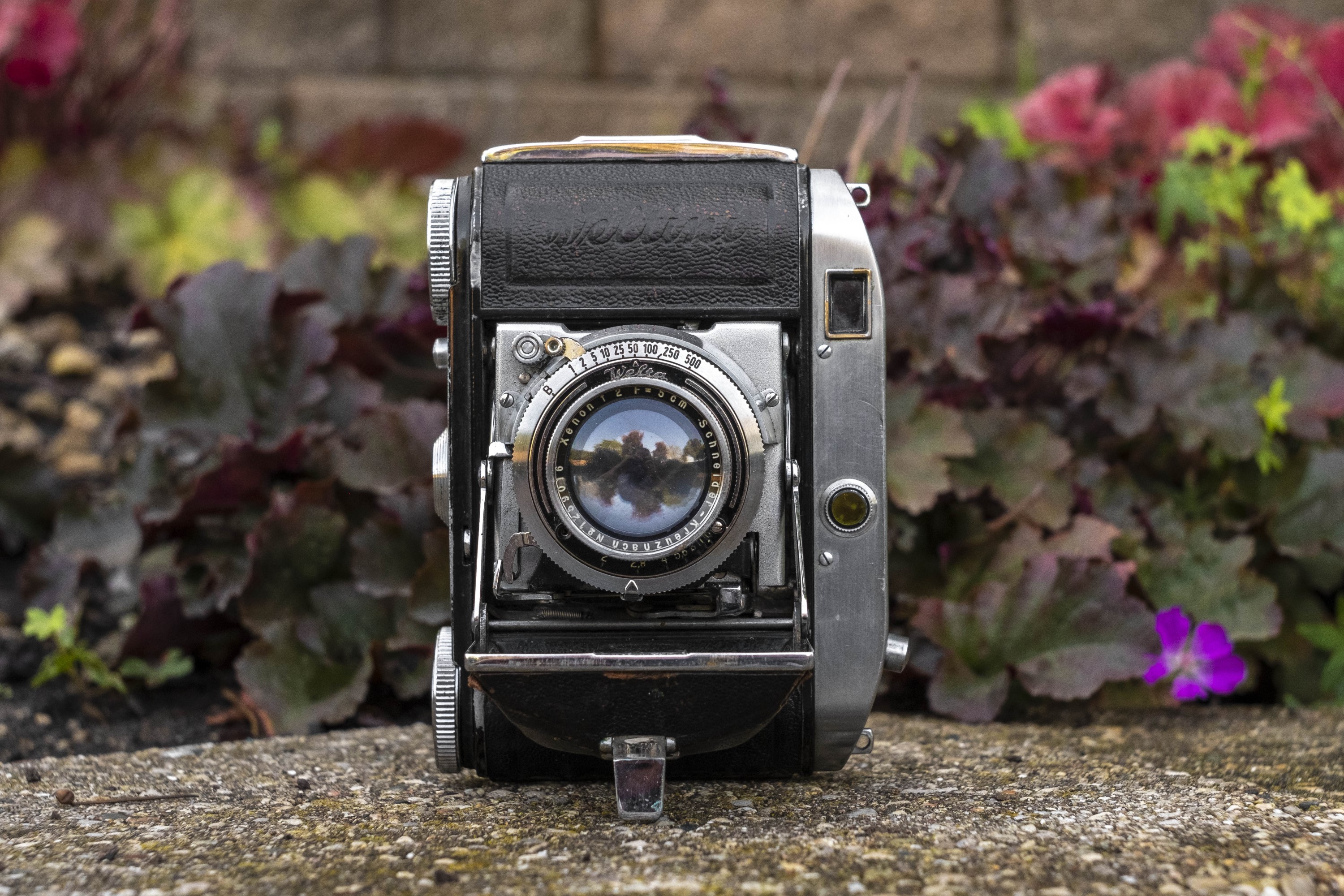

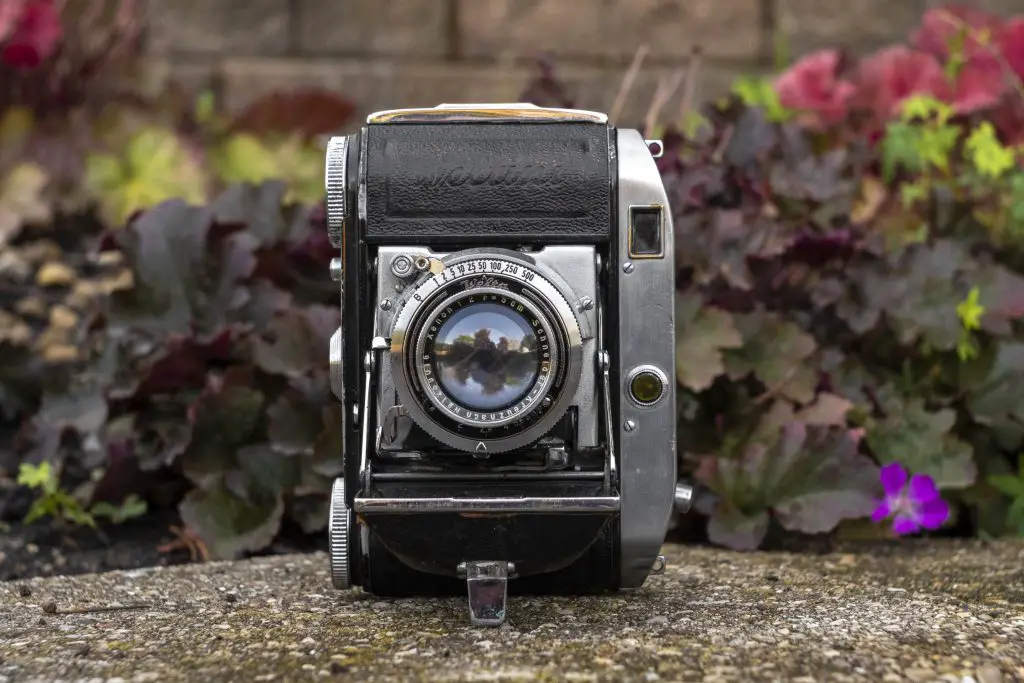













Mike, judging by the press photo with the cyan backdrop, I bet this camera looked a stunner when it was new. I find these folding cameras, whether 35mm or rollfilm based, very appealing in an odd sort of way, from my Agifolds to my two 16-on Zeiss Super Ikontas.
The pressed tin plate for the depth of field scale is interesting in that my Wirgin Edinette has the same feature, but different cosmetically, on the back, so I wonder how many other german cameras of the era would have followed suit?
The Xenon is a well known lens of known performance, and when focused, it shows just how good it is in the sample you have.
Keep up the good work!
I have one friend who loves his Weltini since it is the only camera he has ever found that is comfortable for left-handed people!
The comparison between the Welta 35mm folders and the Kodak Retina cameras is so much fun to dwell on when having examples of both. While I find the Retina’s to feel more compact, I also lament the fact that Kodak did not incorporate the automatic focus return to infinity upon closing the door. For that reason, I do sometimes just grab the Welti or Weltini when I go out to shoot………..for no other reason than closing the Retinas is such a PIA. How could Kodak miss this?
I also have a Weltini II, and I love Welta kameras….. but, as much as I like the look of my Weltini, I did not enjoy using it! I shot a few frames, then reversed the film back out of the kamera……. I found it frustrating to use, and as you say, if that was all you had, and it was 1937-8…… you’d get used to it, but not fun for me, … now. Too bad, as I love my other Welti’s
Love the review anyway, thanks!